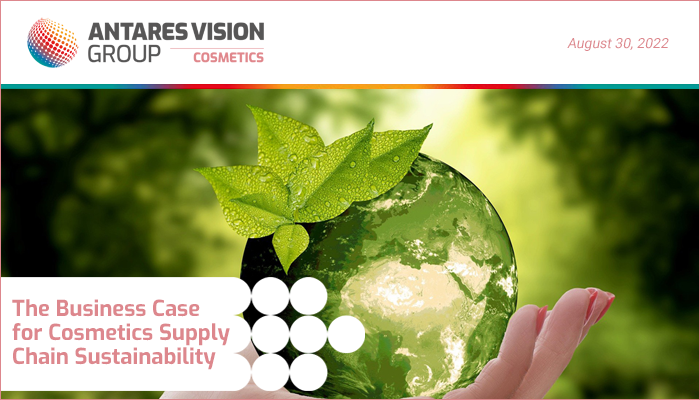The health and beauty industry is under increasing pressure from regulatory bodies and consumers to maintain and demonstrate due diligence in their supply chains. Forward-thinking companies are responding by making cosmetics supply chain sustainability an integral part of their mission statements and consumer engagement activities.
For example, “The Big 3” are prioritizing cosmetics supply chain sustainability. L’Oréal puts environmental and social performance at the heart of its business to drive value. Estée Lauder’s mission is “to bring the best to everyone we touch and to support the environment in which we live.” And Unilever reports thoroughly on environmental and ethical statistics, including water, energy, greenhouse gases, waste and plastic packaging, sustainable sourcing, and community investment.
So let’s take a look at sustainability in the cosmetics supply chain. The industry faces a slew of challenges with sustainability, such as environmental and human rights issues, counterfeiting, an evolving regulatory landscape, changes in consumer behavior, and utilizing new technologies, and all affect their decisions and processes.
What is “sustainability”?
Before we get into cosmetics supply chain sustainability, let’s take a step back for a moment and talk about sustainability generally.
Sustainability might seem to be a relatively new concept, but it has been around since the 19th century, when some industries sought to improve working environments and create less pollution. In the 1960s, new laws and organizational bodies were introduced to address pollution in the United States and Europe.
The U.S. Food and Drug Administration (FDA) “is required under the National Environmental Policy Act of 1969 (NEPA) to evaluate all major agency actions to determine if they will have a significant impact on the human environment.” Federal agencies implement NEPA and evaluate the possibility for environmental impacts by condcuting categorical exclusions, environmental assessments, and environmental impact statements.
The European Commission says it “aims to ensure coherence between industrial, environmental, climate and energy policy to create an optimal business environment for sustainable growth, job creation and innovation.”
In 2015, the Association of Southeast Asian Nations (ASEAN) adopted the ASEAN Socio-Cultural Community Blueprint 2025, which “promotes and ensures balanced social development and sustainable environment that meet the needs of the peoples at all times.”
If you read our Global Cosmetics Market white paper, you’ll know why we used the United States, Europe, and Asia as examples: They’re the world’s top cosmetics markets — and their regulators are concerned about sustainability.
What is cosmetics supply chain sustainability?
Cosmetics supply chain sustainability addresses the environmental and human impact of products, from the sourcing and production of raw materials, through to manufacturing, packaging, distribution to the final customer, and post-consumer activities.
Increasingly, there are calls for cosmetics supply chain sustainability standards to be made mandatory. The European Parliament in March passed a resolution to tackle environmental and human rights in EU supply chains. This new Supply Chain Act will require organizations to integrate sustainability into corporate governance and management systems, and frame business decisions in terms of human rights, climate, and environmental impact.
The United States is yet to follow suit, but consumer groups are letting the government know they want tighter standards for the raw materials used in cosmetics.
Even without government mandates, organizations that want to burnish their environmental credentials would do well start with their supply chains. In a January 2021 report called Net Zero Challenge: The Supply Chain Opportunity, the World Economic Forum states that companies wanting to improve their environmental and social performance can look to their supply chains to make cost-effective improvements.
Environmentally responsible production: the rise of “Clean Beauty”
Much of the drive toward sustainability is coming from consumers, who want to know that ingredients are pure (or at the very least safe) and have been ethically sourced. For example, 62 percent of Generation Z consumers (born in the late 1990s) prefer to buy from sustainable brands, and 73 percent will pay more for sustainable products.
In the United States, where the Food and Drug Administration (FDA) from being used in cosmetics, there is mounting pressure for stricter regulations. For example, environmental and consumer advocate groups such as the Environmental Working Group (EWG) believe more chemicals should banned, like in the EU, where 1,300+ substances are prohibited from being used in cosmetics.
This is part of larger “Clean Beauty” movement that advocates for safe, clean ingredients and transparency in product labeling. According to a
Clean Beauty is also concerned with ethical sourcing of ingredients. Consumers want reassurance that their cosmetics are not linked to issues such as deforestation, pollution, and animal or child cruelty. The primary problem here is that a wide variety of cosmetic products use a few “core” ingredients, many of which pose unique challenges for achieving sustainability in the cosmetics supply chain. They are difficult to obtain sustainably and ethically, and child labor, poor working conditions, and illegal mining are common.
For example, a 2016 report from the Amsterdam-based nonprofit Centre for Research on Multinational Corporations (SOMO) found that more than 20,000 children are forced to work in mica mines while their families live in severe poverty. Similarly, palm oil, the global market for which is expected to reach $57.2 billion by 2026, has a history of human rights problems. Palm oil is used for moisturizing or texture effects.
As more companies stake their reputations on being sustainable and consumers become more aware and demanding, it’s certain that the call for cosmetics supply chain sustainability will only get stronger.
How can we achieve cosmetics supply chain sustainability?
As we’ve seen, cosmetics companies operate in a challenging environment where many groups — including consumers, perhaps their most important audience — are calling for them to achieve sustainability in their supply chains.
To be successful, they must be able to adapt to changes in the market as technology, product development, and consumer sentiment shape the industry. Whether it’s faster production methods, demand for new products, or desire for ethical and sustainable options, companies must be able to change with the market if they want to survive and succeed.
The key takeaway is that cosmetics supply chain sustainability is not a pipe dream. Technology and solutions exist right now to help companies evaluate their operations and identify strengths, weaknesses, and pain points and take corrective action. These include supply chain digitalization, cloud-based data systems, and real-time monitoring. For instance, a 2021 report by Gartner said that digitalization is a key enabler of agility because it supports a more transparent, automated, intelligent, and orchestrated end-to-end supply chain.
Final thoughts
Sustainability. Consumers want it. More and more regulators are demanding it. It’s good for the planet. It’s good for people. It’s a business best practice.
Is it difficult to attain sustainability? Yes and no. It is a process. It has a lot of moving parts that may require tough decisions. But if a company has the will to be sustainable, it can develop strategies, chart a course, and get to work … and reap the benefits.
Technology is essential for sustainability. rfxcel and Antares Vision Group are committed to helping companies meet their sustainability goals and empowering them to protect product, profit, people, and planet.
Our Traceability System enables you to see and follow everything in your supply chain in real time from virtually anywhere in the world. It makes every product a “digital asset” with a certified, sharable provenance that proves to consumers and regulators that your sustainability initiatives are real and working as intended. Its intuitive, scalable solutions can be used individually or as a complete platform to shepherd sustainability initiatives to completion and create end-to-end traceability, transparency, and visibility.
Contact us today to see how it works. And be sure to check out our other resources about the cosmetics industry, sustainability, and traceability:
-
-
- Global Cosmetics Market white paper
- Cosmetics Supply Chain Transparency for Business Value and Opportunity
- Why We Should Worry About Counterfeit Cosmetics
- What Are the Biggest Cosmetics Supply Chain Challenges in 2022?
- Who Investigates Counterfeit Cosmetics Products?
- Top Supply Chain Trends of 2021: The Year in Review
- The Global Seafood Supply Chain and the Importance of Transparency
-





